Part of a series of articles titled Park Paleontology News - Vol. 13, No. 1, Spring 2021.
Article
Following in the footsteps of giants: Dinosaur tracks in Denali National Park and Preserve

Dustin Stewart
University of Alaska Fairbanks
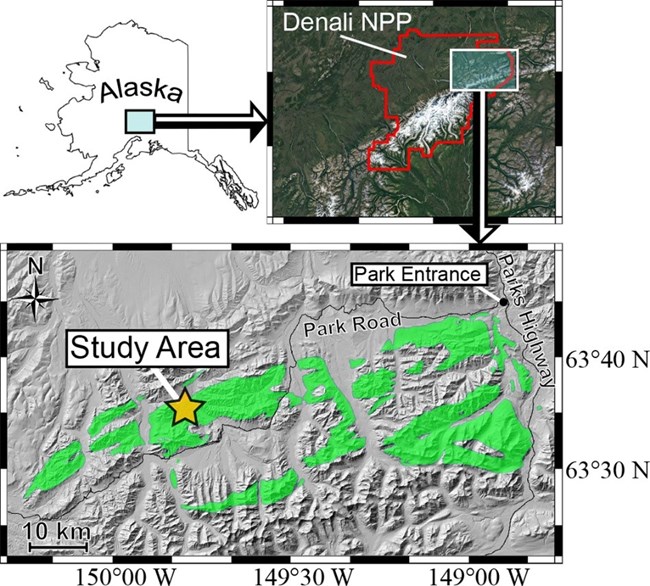
When you think of Alaska, dinosaurs are not usually the first animals to come to mind. At first glance, it doesn’t seem possible that reptiles the size of school busses were capable of surviving in the Arctic. However, in Denali National Park and Preserve (DENA), dinosaurs were not merely surviving, they thrived in biologically diverse ecosystems. Approximately 70 million years ago, during the Late Cretaceous Period, dinosaurs ranging from small feathered deinonychosaurs to towering tyrannosaurs were using DENA as their stomping grounds, leaving their footprints throughout the park. During this time, DENA was further north than the modern latitude of 63.5° N, with some estimates as far north as 81° N. Despite this, an extensive paleobotanical record dominated by deciduous conifers and angiosperms with abundant ferns and horsetails characterize it as a relatively warm polar broad-leaved deciduous forest.
It wasn’t until 2005 that the first dinosaur tracks were found by a field geology class from the University of Alaska Fairbanks, nearly 90 years after the park’s inception. Since then, new sites containing thousands of dinosaur tracks have been discovered on an almost annual basis. Additionally, the tracks can be found alongside the main park road, allowing for easy access for tourists and researchers alike.
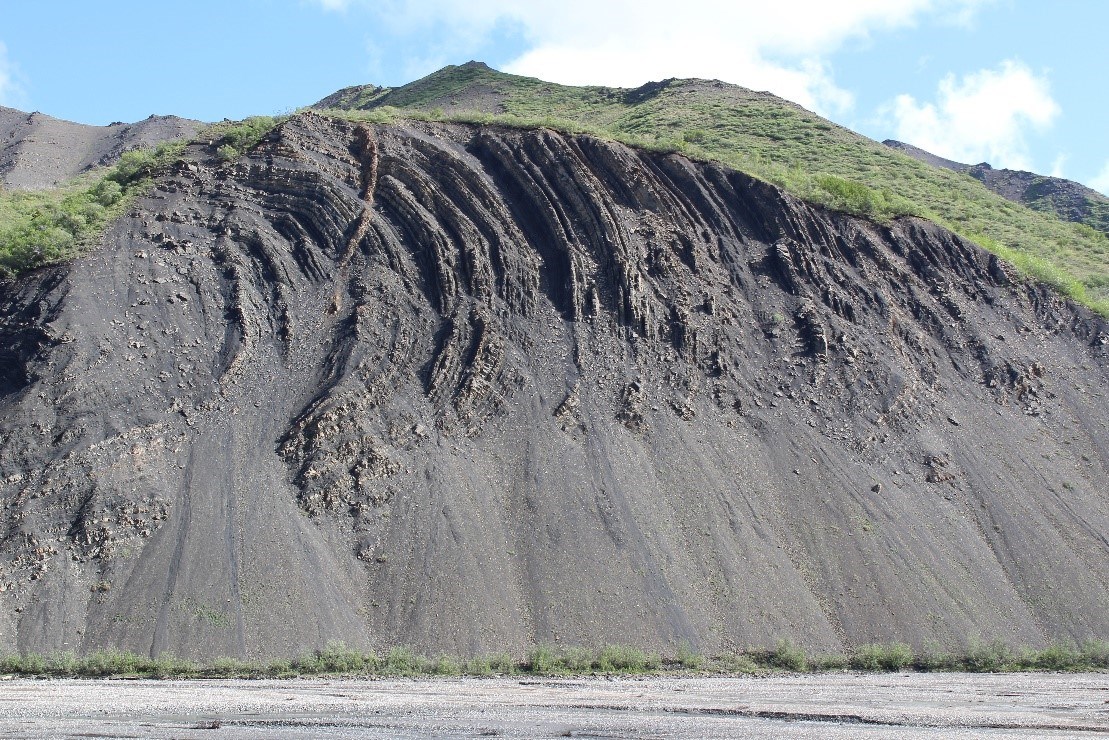
Photo by Dustin Stewart.
Dinosaur tracks are preserved in a 4-kilometer thick package of sedimentary horizons known as the Cantwell Formation. This formation is exposed over a broad area (45 km by 135 km) along an east-west trending basin mostly within the park boundaries (Figure 1). The formation was formed by the accumulating river and lake sediments between the collision of two land masses, the northward-moving Wrangellia Composite Terrane and the continental island Laramidia. The landscape was then uplifted, compressed, pulled apart and sometimes completely overturned (Figure 2). This complicates our ability to correlate the relative age of units and stratigraphic relationships between different track bearing sites in the Cantwell Formation.
Starting in 2016, I began researching the Cantwell Formation with a team from the University of Alaska Museum of the North, led by museum director Dr. Patrick Druckenmiller. We set out to address various unanswered questions such as: (1) How old are the tracks? (2) What types of depositional environments are represented? (3) What types of dinosaurs made the tracks and what does this tell us about dinosaur diversity during the Late Cretaceous at high paleolatitudes? Research continues to show the extensive history of dinosaur presence in the region. There is much work left to do, however, as we are still scratching the surface of paleontological research in DENA.
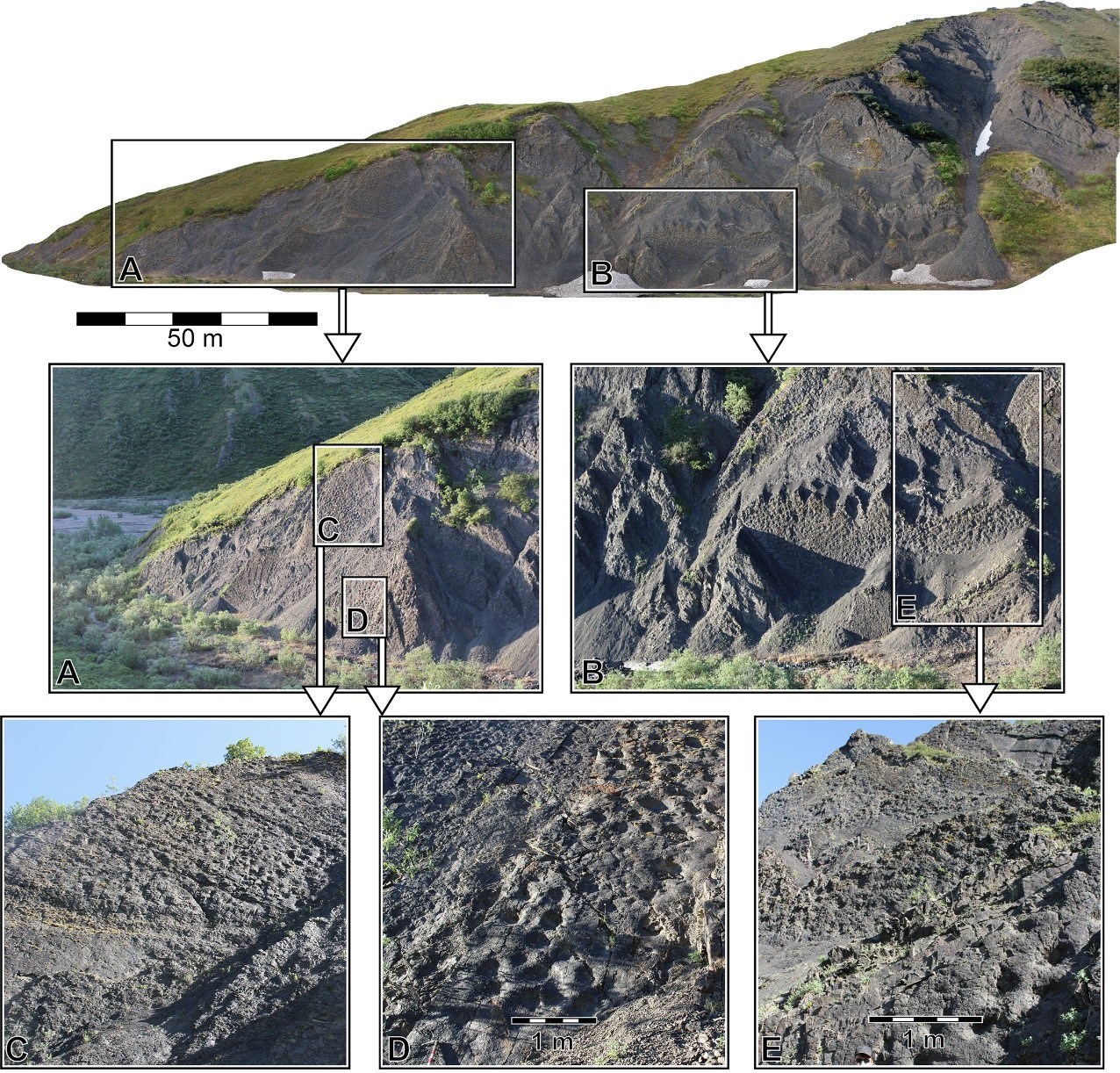
Figure 3. Unmanned Aerial Vehicle (UAV) assisted 3-D model of the Coliseum. Insets depict Photos by Dustin Stewart.
In 2010 an incredible new tracksite was discovered, named “The Coliseum”. The site is an area larger than a football field and consists of more than 65 meters thick of sedimentary rock, making it the largest track-bearing site not only in DENA, but the entirety of Alaska. The area has been tilted to a >70˚ angle incline and has eroded along flat surfaces to expose many hundreds of tracks on multiple beds (Figure 3). The site is challenging to investigate because it is remote and many of the tracks are exposed on cliffsides, which are not easily or safely accessible. A wide variety of dinosaur tracks have been found in the Coliseum, including avian and non-avian theropods, ceratopsids, and ornithopods. Dinosaur trackways are also present, including one composed of more than twenty tracks belonging to a single individual.
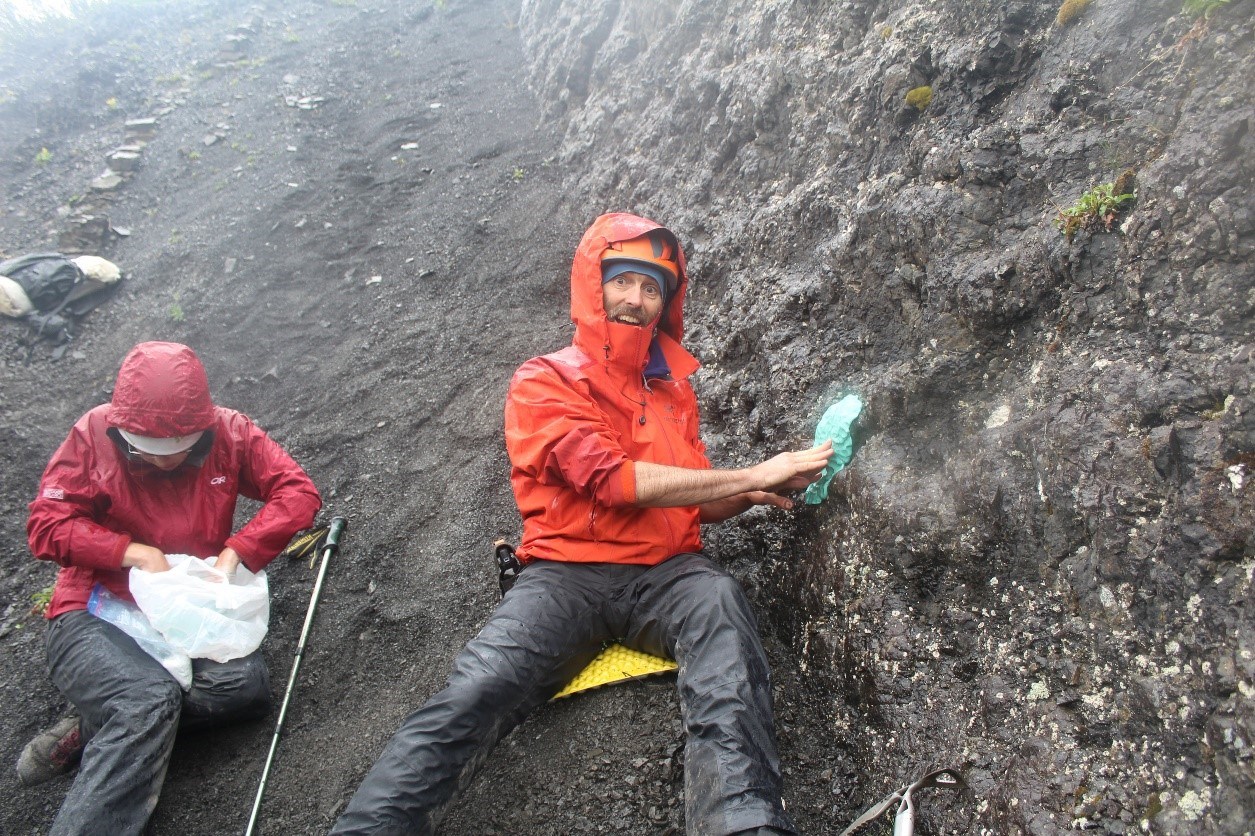
Photo by Dustin Stewart.
As the Coliseum is part of a national park and preserve, it is imperative to use non-destructive methods of data collection in order to study the site. Instead of digging and removing the tracks, they were instead recreated using silicone putty peels (Figure 4) and virtual 3-D models using photogrammetry. Photogrammetry is the science of taking overlapping photographs around a subject at different angles and orientations, processing the photographs using computer software to measure the distance between each photograph, and then using these measurements to generate a 3-D model. Because of the size of the Coliseum and the difficulty of accessing the tracks exposed on the steep cliff faces, we used Unmanned Aerial Vehicle (UAV)-assisted photogrammetry to map the site. On a smaller scale, handheld photogrammetry was used on individual tracks. In these cases, the models of the tracks were processed to generate digital elevation models (Figure 5). The resulting models were used for comparative analyses between other dinosaur tracks and for interpreting probable trackmakers.
To determine the age of the site, we can use samples of bentonite, a mix of fine-grained sediments and volcanic ash with radioactive zircon crystals. Bentonite layers occur laterally between other sedimentary horizons, which allows us to determine the age of the layers of the rest of the formation using uranium-lead radiometric dating. At the Coliseum, a horizon of bentonite was found near the highest point. This allowed for uranium-lead radiometric dating that determined that the site was deposited 69.4 ± 0.9 million years ago.
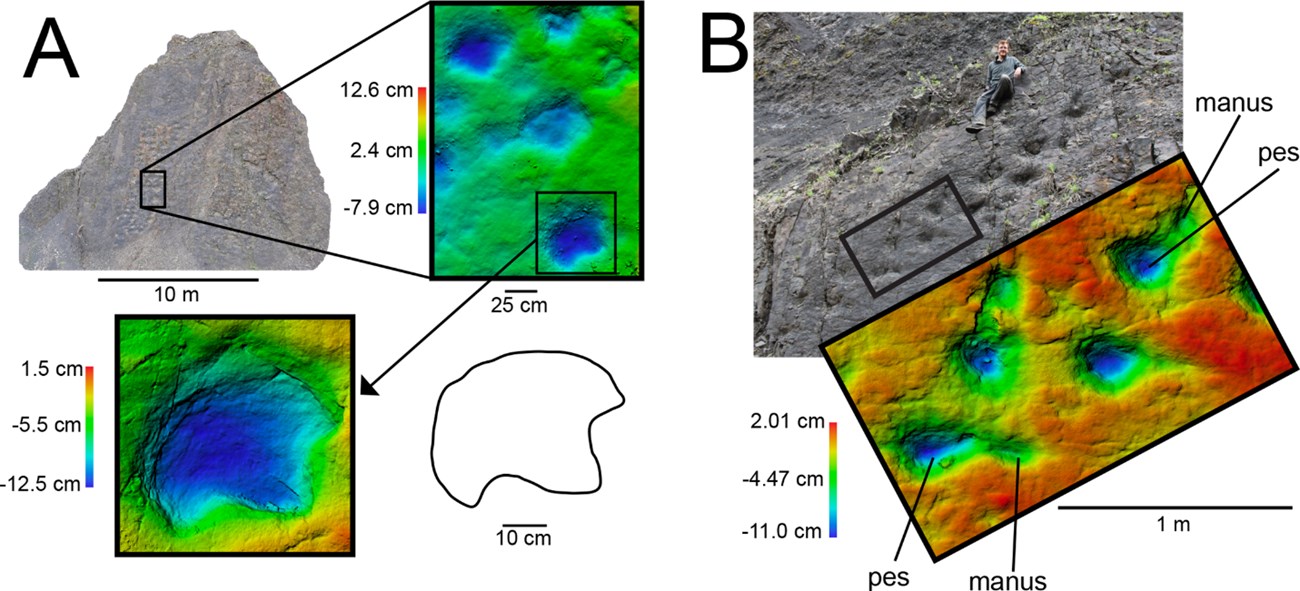
Figure 5. Track-bearing surfaces on uppermost horizons of the site with focus on two isolated ornithopod trackways. A) UAV-assisted 3D photogrammetric model of an isolated region of the Coliseum displaying a heavily bioturbated surface; insets focus on a digital elevation model of three large ornithopod tracks in succession as a trackway. B) Ornithopod trackway represented as a series of undertracks, human for scale. Inset shows photogrammetric digital elevation model of 4 forefeet and 4 hindfeet impressions of the trackway. Photo by Rebecca Missler.
Identifiable tracks in the Coliseum are split into 3 main groups of trackmakers: ornithopods, ceratopsids, and theropods. The range of track sizes is vast, with some horizons preserving 6 cm long bird tracks as well as 60 cm long ornithopod tracks, with some tracks preserving highly detailed skin impressions. The sedimentary horizons of the Coliseum also shed light on the environment that these dinosaurs were living in. The Coliseum is characterized by a mix of planar, laterally continuous sandy and muddy beds, containing abundant aquatic plants and invertebrates. The paleoenvironment that is consistent with these beds is interpreted as an organically rich wetland, regularly flooded with sandy splays by a nearby river system (Figure 6).
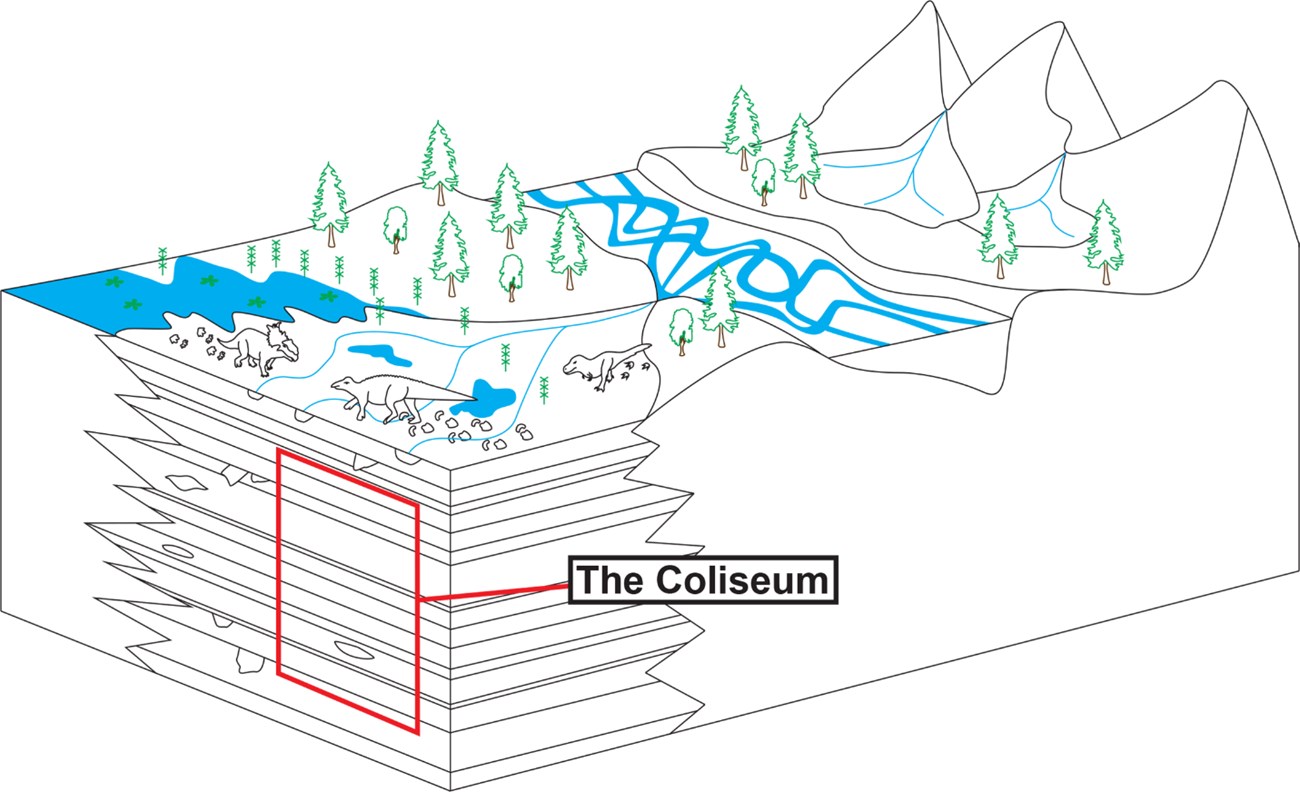
With new and exciting discoveries being found each year, DENA is quickly becoming one of the most significant resources for high-latitude paleontological study. From backcountry sites such as the Coliseum, to tracks accessible a short walk from the park road, all visitors to DENA have a chance to view footprints laid down by dinosaurs up close and personal, making the dinosaurs of Denali a welcome addition to the already awe-inspiring majesty of the park.
Related Links
-
Denali National Park and Preserve—[Geodiversity Atlas] [Park Home]
- NPS—Fossils Through Geologic Time
- NPS—Fossils and Paleontology
Last updated: March 12, 2021
